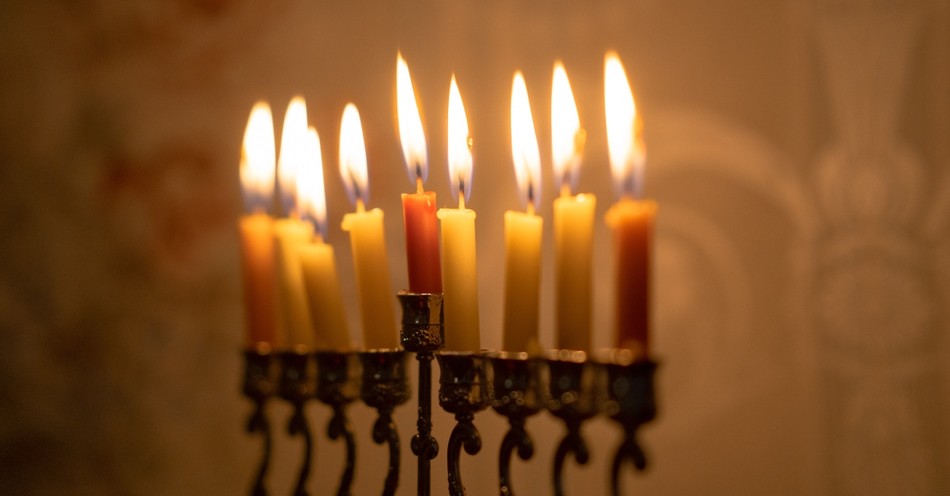In the Gospel of John, Jesus participates in the Feast of Dedication. Interestingly, the Old Testament doesn’t mention this feast, yet the New Testament records that Jesus taught during the celebration. The Old Testament highlights three main feasts for Israel—Passover, Pentecost, and the Feast of Tabernacles and it is only in the New Testament that we see mention of the Feast of Dedication which is today known more familiarly as Hanukkah.
Passover commemorates Israel’s deliverance from Egyptian slavery to enter the Promised Land. Fifty days after Passover, the Feast of Pentecost (also known as the Feast of Weeks or Shavuot) takes place. This celebrates the first fruits of the wheat harvest and gives thanks for God’s provision. The third main feast, the Feast of Tabernacles, took place in the fall, at the end of the harvest. During this time, Israelites built temporary shelters or booths to remember their historical time in the wilderness where they lived in tents. So, what about the Feast of Dedication? Let's explore more below.
Where is the Feast of Dedication Mentioned in the Bible?
John 10:22-23 mentions the Feast of Dedication, also known today as Hanukkah. “Then came the Festival of Dedication at Jerusalem. It was winter, and Jesus was in the temple courts walking in Solomon’s Colonnade.” This Jewish festival commemorates the rededication of the Second Temple after Antiochus Epiphanes’ desecration during the Maccabean Revolt (164 BC). In the Feast of Dedication, the Jews remembered God’s intervention in their history and celebrated the restoration of their place of worship.
In John 10, Jesus ministers in Jerusalem and participates in the feast. As he walked the temple courts, the Jews gathered around him and asked him, “How long will you keep us in suspense? If you are the Messiah, tell us plainly.” (John 10:24) Because of the prophets Isaiah, Jeremiah, and especially Daniel, the Jews anticipated the Messiah would arrive soon, and since Jesus’ ministry produced miracles and gained popularity, the leaders and people wanted to know his identity. However, they awaited a Messiah who would bring political deliverance and restoration, much like the Maccabees fought for.
With the background of the Feast of Dedication in mind, it's noteworthy to see how Jesus shifts the focus from a political Messiah to a spiritual deliverer. “I did tell you, but you do not believe. The works I do in my Father’s name testify about me.” (v. 25) Christ points to his miracles and teachings as witness enough; those declare his identity as the Son, working in his Father’s name. In the chapter, Jesus continues to talk about his followers, referring to them as his sheep who listen to his voice and follow him. This references Old Testament passages about the Jewish leaders being “bad shepherds” and how God himself would be their shepherd (Ezekiel 34:1-16, Jeremiah 23:1-6, and more), where Jesus indirectly declares himself divine.
Toward the end of his teaching during the Feast of Declaration, Jesus makes a profound statement regarding his “sheep”: “I will give them eternal life, and they shall never perish; no one will snatch them out of my hand.” (v. 28) After Jesus says, “I and my Father are one,” the Jews pick up stones to kill him. Since it was not yet his time, Christ escaped from their hands.
What is the Historical Background of the Feast of Dedication?
The Seleucid ruler, Antiochus IV Epiphanes, tried to force Hellenistic (Greek) culture and religion upon the Jews and erase their religious heritage and identity. In 167 BC, he desecrated the Second Temple by sacrificing pigs (ceremonially unclean animals) on the altar and setting up an idol of Zeus within the temple courts. These actions outraged the Jewish community. He also outlawed Jewish religious practices, such as observing the Sabbath, studying the Torah, and circumcision, which intensified the Jewish resistance.
A Jewish priest named Mattathias, along with his five sons, led a rebellion against the Seleucid empire. After Mattathias’ death, his son Judas Maccabeus took over leadership and proved to be a courageous leader. Under Judas’ leadership, the Jewish forces (now known as the Maccabees) fought a successful war against the bigger Seleucid army. By 164 BC, they reclaimed Jerusalem and the Temple.
The victory allowed the Maccabees to cleanse and rededicate the Temple. According to tradition, when the Maccabees attempted to relight the lampstand, a menorah, they found only enough oil for one day. Miraculously, that small amount of oil lasted eight days, long enough for more oil to be prepared and consecrated according to the Law. From this event, the Jews instituted a new festival, the Feast of Dedication, lasting for eight days.
Hannukah means dedication, and it celebrates the triumph of light over darkness, purity over corruption, and the Jewish identity over oppression. The rededication of the Temple testifies to God’s faithfulness to the Jewish people and their courage in the face of tyranny.
Since this happened after the writing of Malachi, the last book in the Old Testament, we don’t read about the event or the holiday until John 10 in the New Testament.
How is the Feast of Dedication Celebrated Today?
Jewish communities around the world celebrate the Feast of Dedication as Hanukkah. It recalls the events of the Maccabean Revolt and the miracle of the menorah oil lasting eight days.
Hanukkah celebrations last for eight days, and each night, one candle is added to the menorah (also called the Hanukkiah, a nine-branched lampstand), with a central candle, called the shamash, used to light the others. Every home has a menorah, and the lighting of the candles becomes the focus of the celebration, representing the light of God shining in a time of darkness. Many Jews put the menorah in windows or other visible places as a testimony of God’s faithfulness to others.
Families gather each Hanukkah night to light the candle, recite prayers, and sing traditional songs. A well-known prayer is the Haneirot Halalu, praising God for the miracles he performed for the Jewish people during the time of the Maccabees. Hanukkah celebrations include foods like latkes (potato pancakes) and sufganiyot (jelly-filled doughnuts) which are fried in oil as more symbolism with the eight-day miracle.
Gift-giving has become a popular part of modern Hanukkah celebrations, especially in Western cultures, possibly because of the Christmas influence and to better include children. While giving gifts isn’t part of the traditional observance, it has become a meaningful way to celebrate. Gifts are often exchanged each night after the family lights the menorah to connect with gratitude for God’s generosity, encouraging Jews to share blessings with others.
How Does the Feast of Dedication Point to Christ?
In John 10, Jesus teaches in the Temple during the Feast of Dedication. While the festival celebrated the physical restoration of the Temple (an important event), Jesus used the holiday to reveal deeper things about himself, his identity, his followers, and those who resisted him.
Light becomes a central theme of Hanukkah, with the lighting of candles based on the miracle. Jesus directly connects himself to this theme of light when he says, “I am the light of the world. Whoever follows me will never walk in darkness, but will have the light of life.” (John 8:12) Declaring this during the Feast of Dedication isn’t a random coincidence. Just as the menorah symbolized God’s presence and miraculous provision, Jesus is the supernatural light and life to a dark and dying world.
Hanukkah also relates to Jesus’ parable of the foolish virgins and their oil (Matthew 25:1-13). Both reveal the importance of being prepared and vigilant for God to appear. Hanukkah celebrates the miracle of the oil that lit the temple, symbolizing God’s provision. In Jesus’ parable of the virgins, the wise virgins bring extra oil, prepared for the bridegroom’s return, while the foolish ones are left in the dark, missing the wedding party. The wedding symbolizes both Christ’s arrival as Messiah two thousand years ago and his future return. The oil represents the Spirit of God, telling us we need to remain connected and engaged with the Spirit so we don’t miss Jesus’ coming.
Many missed his coming the first time. In John 10, Jesus contrasts himself with the religious leaders of the time, portraying them as the true oppressors rather than foreign rulers like the Seleucids. He identifies himself as the “Good Shepherd” who cares for his sheep, directly opposing the Pharisees and Jewish leaders, whom he calls thieves and robbers. Those leaders, instead of guiding the people toward God’s truth, mislead and exploit them to gain their own power.
Using this imagery, Jesus points to the failure of Jewish leaders. His declaration, “I am the door,” reveals salvation and truth come through him, not through the corrupt leaders. The Seleucids, despised by the Jews, aren’t Jesus’ focus. Instead, he exposes the religious authorities and the Jews, challenging their role as the real spiritual oppressors. They prove him right when they try to kill him, the Son of God.
Yet God does have a people. The menorah reminds the Jews of God’s covenant and presence with his people, but Jesus and the New Testament expands this. No longer is the light in a physical temple. Jesus offers his light to all people, illuminating their hearts and offering eternal life. He speaks of the true people of God, his “sheep,” the ones who enter through him and not corrupt leaders. His sheep hear his voice, through the Holy Spirit, and won’t follow another, even those disguised in Jewish priestly garments. Through Christ, the church becomes the temple of God. As 1 Corinthians 3:16 says, “Don’t you know that you yourselves are God’s temple and that God’s Spirit dwells in your midst.” God’s desire has always been for a people. And through Jesus, the light of God now dwells with his people, the church. Through his death and resurrection, Jesus provided a way for us to be restored to God, making us holy and pure. In Ephesians 5:8, Paul writes, “For you were once darkness, but now you are light in the world. Live as children of light.”
Before, we didn’t just live in darkness. Paul says we were darkness. Now, through Christ, our identity has changed. Being in Christ and the Spirit in us, we become the light of the world.
As Jesus fulfilled the Law, he also fulfills the hope of the Feast of Dedication. His presence in the Temple during Hanukkah taught that the time of physical restoration was transcended by a greater spiritual one. Through Christ, we no longer rely on temporary, practical symbols, but on the Person of eternal light and life.
As the Feast of Dedication celebrates the physical temple’s rededication, Jesus invites us to experience miraculous ongoing spiritual renewal and prepare for his ultimate return, when he will end all corruption and bring complete restoration to all creation.
Peace.
Further Reading
10 Important Jewish Holidays Christians Should Know About
Hanukkah: Bringing More Light into the World
Photo credit: Pexels/cottonbro



.jpg)
